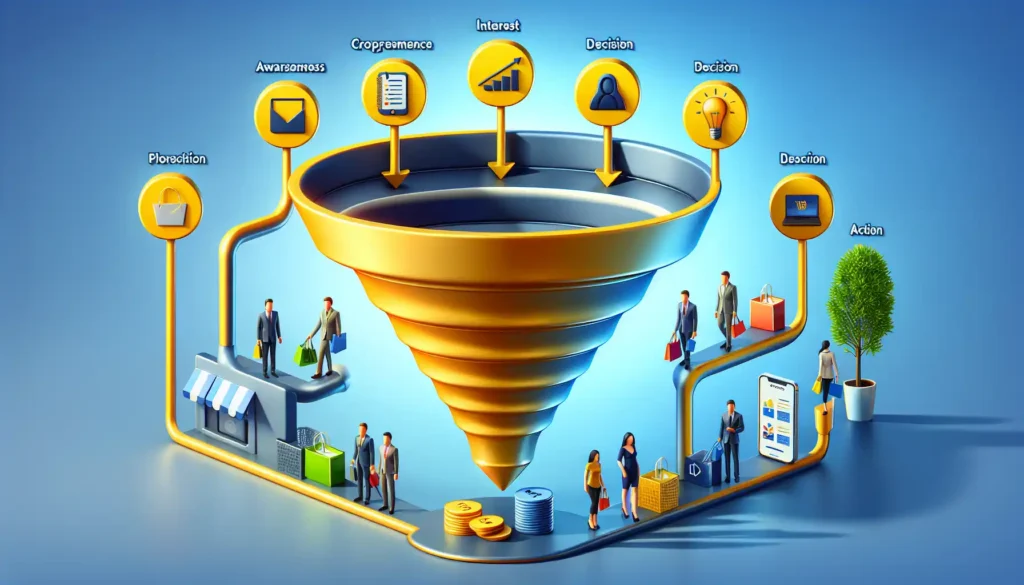
Conversion Funnel: Unlocking E-commerce Success Explained

In the rapidly evolving world of online retail, understanding the conversion funnel e-commerce is essential for businesses looking to maximize their sales and foster lasting customer relationships. As e-commerce continues to dominate the retail landscape, brands must strategically optimize their conversion funnels to guide potential customers seamlessly from awareness to purchase. The ability to effectively engage consumers at each stage of this conversion funnel can significantly impact a company's bottom line, driving both immediate sales and sustainable growth.
As shoppers become increasingly discerning, the need for a well-designed conversion funnel e-commerce has never been more critical. To achieve e-commerce success, businesses must not only attract visitors but must also nurture them through the journey, ensuring that they have the knowledge and confidence to make a purchase. By implementing targeted strategies at each stage of the funnel, brands can unlock numerous opportunities to engage customers, overcome obstacles, and ultimately increase conversion rates.
Table of Contents
- Understanding the Conversion Funnel: Key to E-commerce Triumph
- The Importance of Optimization in E-commerce Sales Funnels
- Top of the Funnel: Attracting Visitors with Effective Strategies
- Mid-Funnel Engagement: Enhancing User Experience and Education
- Bottom of the Funnel: Techniques to Maximize Conversion Rates
- The Role of Promotions and Upselling in Driving Sales
- Retaining Customers: Building Loyalty and Encouraging Repeat Business
- Leveraging Analytics: Measuring Performance and User Behavior
- Identifying and Addressing Drop-off Points in the Funnel
- The Impact of Social Media and SEO on E-commerce Success
- Transforming Single Sales into Long-term Customer Relationships
- Enhancing Customer Support: The Benefits of Live Chat and Resources
Understanding the Conversion Funnel: Key to E-commerce Triumph
The conversion funnel e-commerce represents the various stages a customer goes through, from discovering a product to making a purchase. Each stage plays a distinct role in the user journey, and understanding the flow of this journey is critical for e-commerce success. Typically, the funnel consists of three main stages: the top, mid, and bottom funnels. At each of these stages, businesses have unique opportunities to optimize engagement and drive conversions.
To effectively navigate the funnel, it is important to recognize how customers interact with your brand and the decisions they make along the way. By analyzing these interactions and identifying drop-off points, businesses can implement targeted improvements to keep potential customers moving forward in the process. Let’s explore each stage of the funnel in depth to uncover the strategies that can make a substantial difference in e-commerce performance.
The Importance of Optimization in E-commerce Sales Funnels
Optimizing every stage of the conversion funnel e-commerce is crucial for increasing overall conversion rates and enhancing revenue. When businesses take a holistic approach to optimization, they focus not just on closing sales, but also on smoothing the journey for customers. This requires constant evaluation and adjustment undertaken through data analysis, A/B testing, and customer feedback.
Companies should periodically assess digital touchpoints, website flow, and communication strategies to ensure that potential customers receive the relevant information they need. Neglecting to optimize the funnel can lead to customer frustration and abandoned carts. By prioritizing optimization metrics and techniques, businesses can identify which strategies resonate with their audience and drive successful conversions.
Top of the Funnel: Attracting Visitors with Effective Strategies
At the top of the funnel, the primary goal is to attract visitors and generate interest in your products. To accomplish this, businesses can employ a range of effective strategies:
- Search Engine Optimization (SEO): Enhancing website visibility through keywords, quality content, and backlinks helps potential customers discover your brand organically.
- Social Media Advertising: Promoting products through targeted social media ads creates engaging content that can capture attention and drive traffic to your website.
- Content Marketing: Creating valuable and informative content, such as blog posts, videos, and infographics, establishes authority and encourages visitors to learn more about your offerings.
- Influencer Partnerships: Collaborating with social media influencers can expand your reach and attract their followers to your brand.
By effectively implementing these strategies, businesses can increase brand awareness and capture the interest of potential customers in the very first stage of their journey.
Mid-Funnel Engagement: Enhancing User Experience and Education
Once potential customers enter the mid-funnel stage, the focus shifts to enhancing their experience and providing valuable education about your products. At this stage, user experience is paramount:
- Showcase Product Features: Highlighting key features and benefits enables customers to see the value of your products.
- Customer Reviews and Testimonials: Providing social proof through positive feedback from previous buyers builds trust and showcases the quality of your offerings.
- Product Guides and How-tos: Offering educational resources helps customers better understand how to use your products effectively, reducing hesitation.
- Live Chat Support: Implementing real-time customer assistance addresses inquiries instantly, alleviating concerns that may lead to drop-offs.
By prioritizing user experience and offering valuable educational resources, businesses can create a deeper connection with potential customers, ultimately nurturing their journey toward a purchase.
Bottom of the Funnel: Techniques to Maximize Conversion Rates
The bottom of the funnel is where actionable strategies come into play as businesses aim to maximize conversion rates. At this stage, several techniques can encourage final purchases:
- Promotions and Discounts: Offering limited-time discounts or exclusive deals can create a sense of urgency that prompts customers to complete their transactions.
- Upselling and Cross-selling: Suggesting related products or upgrades can increase order value while providing customers with options that suit their needs.
- Handling Objections: Proactively addressing common objections through FAQs or live chats can minimize barriers to entry.
- Remarketing Strategies: Utilizing retargeting ads and personalized emails can draw back previous visitors who showed interest but did not convert.
- Abandoned Cart Emails: Sending reminder emails to cart abandoners serves as a gentle nudge to encourage them to complete their purchase.
Implementing these effective strategies at the bottom of the funnel can significantly drive conversions, ultimately leading to increased revenue for e-commerce businesses.
The Role of Promotions and Upselling in Driving Sales
Part of maximizing sales at the bottom of the funnel involves utilizing promotions and upselling techniques. Promotions can create urgency, especially during crucial shopping periods, such as holidays or special events. Businesses must leverage various promotional tactics, such as:
- Seasonal Sales: Organizing sales events during holidays or sales seasons encourages purchases.
- Discount Codes: Distributing personalized discount codes can drive customers to shops, creating a sense of exclusivity.
- Buy One Get One (BOGO): This tactic entices customers to purchase more items by offering them an attractive deal.
- Free Shipping: Providing free shipping for orders above a certain threshold can incentivize customers to increase their cart value.
Additionally, upselling and cross-selling techniques encourage customers to consider higher-value products or add-ons that complement their original purchase. With well-placed recommendations and enticing offers, brands can significantly boost their average order value (AOV) and drive more revenue.
Retaining Customers: Building Loyalty and Encouraging Repeat Business
While attracting new customers is undoubtedly valuable, retaining existing ones is equally essential for long-term success. Building customer loyalty is paramount in transforming one-time buyers into repeat customers. Businesses can employ several strategies such as:
- Loyalty Programs: Creating rewards programs can encourage customers to keep returning for exclusive discounts and promotions.
- Personalized Communication: Sending tailored emails or messages based on customers' purchase history can enhance their experience and encourage repeat visits.
- Referral Marketing: Incentivizing customers to refer friends and family can create a network of loyal shoppers.
- Customer Appreciation Events: Hosting exclusive events for loyal customers fosters community and deepens relationships.
By prioritizing customer retention and engagement, businesses can increase loyalty and create a sustainable revenue stream that can significantly impact their bottom line.
Leveraging Analytics: Measuring Performance and User Behavior
Monitoring the performance of the conversion funnel e-commerce through analytics is vital for success. Utilizing data analytics tools can provide businesses with valuable insights to measure performance and understand user behavior:
- Tracking Key Performance Indicators (KPIs): Metrics such as conversion rates, click-through rates, and average order value can help gauge funnel efficiency.
- User Behavior Analysis: Tools like heatmaps and session recordings can reveal how visitors interact with your website, helping identify confusing navigation paths.
- A/B Testing: Running tests on different funnel elements allows businesses to determine which variations yield the best results.
- Segmentation and Targeting: Understanding different customer segments can enable tailored messaging that resonates with specific groups.
By leveraging analytics, businesses can continuously refine their conversion funnel e-commerce strategies, ensuring that they align with evolving customer demands and expectations.
Identifying and Addressing Drop-off Points in the Funnel
One of the most critical aspects of optimizing the conversion funnel e-commerce is identifying and addressing drop-off points. These points are where potential customers abandon their journey, which can lead to lost sales opportunities. Common drop-off points include:
- High Cart Abandonment Rates: If users leave items in their cart without completing purchases, it’s essential to analyze potential reasons and implement remedial strategies.
- Complex Checkout Process: Lengthy or complicated checkout processes can deter customers from completing their orders. Streamlining this process can help keep customers on track.
- Poor Mobile Experience: With a growing number of users shopping on mobile, ensuring that the mobile site is responsive and easy to navigate is critical.
- Unclear Pricing: Hidden fees or complicated pricing models can frustrate customers. Clear pricing information should be provided upfront.
By proactively addressing these drop-off points, businesses can help retain potential customers along their journey and maximize conversions.
In today's digital landscape, online presence plays a pivotal role in determining e-commerce success. Two fundamental components of this presence are social media and SEO. Businesses must harness these tools effectively to create brand visibility and attract traffic to the conversion funnel e-commerce:
- Social Media Engagement: Creating shareable content and actively engaging with potential customers through platforms like Instagram and Facebook fosters brand loyalty and encourages word-of-mouth marketing.
- SEO Best Practices: Implementing on-page optimization strategies, including keyword targeting, alt tags, and meta descriptions, helps newcomers discover a business’s online store organically.
- Content Sharing: Encouraging sharing of product content through social media can result in increased visibility and drive traffic to the funnel.
- Influencer Collaborations: Partnering with influencers to amplify product reach adds credibility and trust, crucial elements in driving traffic and conversions.
With both SEO and social media effectively utilized, businesses can enhance their visibility and subsequently open pathways for potential customers through the funnel.
Transforming Single Sales into Long-term Customer Relationships
Transforming a single sale into a long-term customer relationship requires businesses to engage customers post-purchase actively. Strategies such as:
- Follow-Up Emails: Reaching out to customers after their purchase to thank them and suggest additional products fosters goodwill.
- Subscription Services: Offering automated replenishment for consumables can ensure recurring income while providing convenience to customers.
- Feedback Requests: Encouraging feedback on their shopping experience helps customers feel valued and engaged.
- Exclusive Offers for Repeat Buyers: Incentivizing repeat purchases through special offers can motivate customers to return.
By prioritizing post-purchase communication and engaging customers as valued individuals, it becomes feasible to transform single transactions into enduring relationships.
Enhancing Customer Support: The Benefits of Live Chat and Resources
Customer support plays a significant role throughout the conversion funnel e-commerce. The right support channels enhance user experience and build confidence, driving conversions:
- Live Chat: Implementing live chat support provides immediate assistance, answering questions in real-time and improving the customer's experience.
- Comprehensive FAQs: Having a well-organized FAQ section can alleviate common concerns and confusion, guiding customers in making decisions.
- Resource Center: Building strong educational resources, such as video tutorials, guides, and blogs, can help prospects understand products better.
- Email Support: Providing a responsive email support service ensures customers receive timely assistance and build confidence in purchasing.
Through effective support, businesses can resolve customer concerns swiftly, which not only helps boost conversions but also contributes to long-term loyalty.
To conclude about - conversion funnel e commerce
The conversion funnel e-commerce is a vital component of any successful online retail strategy. By understanding the journey consumers undertake and optimizing every stage of the funnel, businesses can effectively guide potential customers from initial awareness to final conversion. Strategic engagement and communication, supplemented by effective analytics and support, will help businesses not only harness opportunities for immediate sales but also foster lasting relationships that drive repeat business. By embracing the principles of funnel optimization, e-commerce businesses can chart a course for sustainable success and growth in an increasingly competitive environment.
If you want to know other articles similar to Conversion Funnel: Unlocking E-commerce Success Explained and can visit the categoryMarketing.
Go up






Leave a Reply